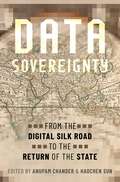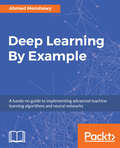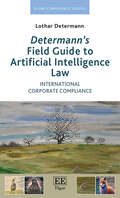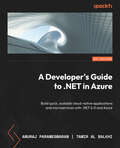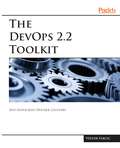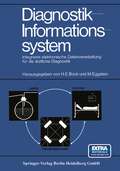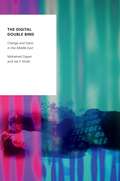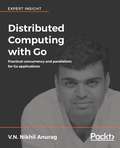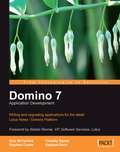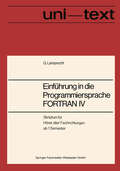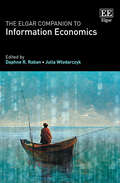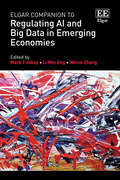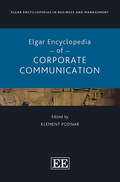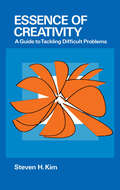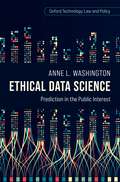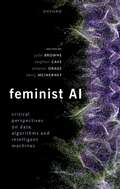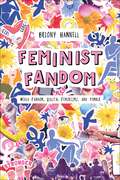- Table View
- List View
Data Sovereignty: From the Digital Silk Road to the Return of the State
Who, if anyone, should regulate the internet? Governments around the world have answered this question robustly: they will. Data sovereignty-the exercise of control over the internet-is the ambition of world leaders as a natural extension of traditional sovereignty and as a bulwark against the reach of foreign power. The question posed to governments now is not who should regulate the internet, but how should it be done. Data Sovereignty: From the Digital Silk Road to the Return of the State focuses on the question of territorial control over data flows and attempts by national and regional governments to place limits on the free movement of data across a global internet. Drawing on theories in political economy, international law, human rights, and data protection, this volume offers new theoretical perspectives and thought-provoking ideas about the nature and scope of data sovereignty. It examines the extent to which new technologies, such as artificial intelligence, robotics, and automation, pose challenges to data sovereignty and how those challenges might be addressed. In chapters that are both descriptively comprehensive and analytically rich, the book explains the national, regional, and international legal frameworks for regulating the digital economy. Professors Anupam Chander and Haochen Sun have assembled a distinguished team of experts across multiple fields to address the promise and pitfalls of data sovereignty in the context of trade liberalization, data localization, and human rights protection. In a world that is still grappling with the scope of the internet, Data Sovereignty offers a timely and thorough investigation of the ongoing conflict between the state and the internet. This is an open access title available under the terms of a CC BY-NC-ND 4.0 International licence. It is free to read on Oxford Scholarship Online and offered as a free PDF download from OUP and selected open access locations.
Deep Learning By Example: A hands-on guide to implementing advanced machine learning algorithms and neural networks
by Ahmed MenshawyGrasp the fundamental concepts of deep learning using Tensorflow in a hands-on mannerAbout This BookGet a first-hand experience of the deep learning concepts and techniques with this easy-to-follow guideTrain different types of neural networks using Tensorflow for real-world problems in language processing, computer vision, transfer learning, and moreDesigned for those who believe in the concept of 'learn by doing', this book is a perfect blend of theory and code examplesWho This Book Is ForThis book targets data scientists and machine learning developers who wish to get started with deep learning. If you know what deep learning is but are not quite sure of how to use it, this book will help you as well. An understanding of statistics and data science concepts is required. Some familiarity with Python programming will also be beneficial.What You Will LearnUnderstand the fundamentals of deep learning and how it is different from machine learningGet familiarized with Tensorflow, one of the most popular libraries for advanced machine learningIncrease the predictive power of your model using feature engineeringUnderstand the basics of deep learning by solving a digit classification problem of MNISTDemonstrate face generation based on the CelebA database, a promising application of generative modelsApply deep learning to other domains like language modeling, sentiment analysis, and machine translationIn DetailDeep learning is a popular subset of machine learning, and it allows you to build complex models that are faster and give more accurate predictions. This book is your companion to take your first steps into the world of deep learning, with hands-on examples to boost your understanding of the topic.This book starts with a quick overview of the essential concepts of data science and machine learning which are required to get started with deep learning. It introduces you to Tensorflow, the most widely used machine learning library for training deep learning models. You will then work on your first deep learning problem by training a deep feed-forward neural network for digit classification, and move on to tackle other real-world problems in computer vision, language processing, sentiment analysis, and more. Advanced deep learning models such as generative adversarial networks and their applications are also covered in this book.By the end of this book, you will have a solid understanding of all the essential concepts in deep learning. With the help of the examples and code provided in this book, you will be equipped to train your own deep learning models with more confidence.Style and approachA step-by-step guide filled with multiple examples to help you get started with data science and deep learning.
Determann’s Field Guide to Artificial Intelligence Law: International Corporate Compliance (Elgar Compliance Guides)
by Lothar DetermannWith Determann’s Field Guide to Artificial Intelligence Law, readers can navigate a complex field traversing new technologies, business models, risks, rights, and legal issues. The author presents practical recommendations in a user-friendly and accessible format, designed to help organizations build and maintain their AI compliance and risk mitigation programs. A leading voice on data and technology law, Lothar Determann discusses existing and new laws pertaining to AI around the world and examines distinct advantages of different governance models.Key Features:Roadmap on how to identify, prioritize, and address risks and compliance obligationsChecklists, action items, and sample protocolsA-to-Z list of risks and mitigation measuresExamples of jurisdiction-specific legal requirementsGuidance on governance and accountability mechanismsPractitioners in corporate legal departments and private practice, compliance officers, programmers, privacy officers, data scientists, human resources (HR) specialists, and other professionals who must address AI and related legal compliance issues will find the guidance on risk assessments and mitigation, data law compliance, intellectual property, and other AI-related topics a vital resource.
A Developer's Guide to .NET in Azure: Build quick, scalable cloud-native applications and microservices with .NET 6.0 and Azure
by Anuraj Parameswaran Tamir Al BalkhiDevelop cloud-native applications using serverless technologies, Azure services, and .NET with the help of this reference guideKey FeaturesCreate cloud-native .NET applications using cutting-edge technologiesDesign, develop, and deploy scalable, manageable, and resilient apps with various Azure servicesExplore serverless architecture and optimize application scalability through efficient designPurchase of the print or Kindle book includes a free PDF eBookBook DescriptionA Developer’s Guide to .NET in Azure helps you embark on a transformative journey through Microsoft Azure that is tailored to .NET developers. This book is a curated compendium that’ll enable you to master the creation of resilient, scalable, and highly available applications. The book is divided into four parts, with Part 1 demystifying Azure for you and emphasizing the portal's utility and seamless integration. The chapters in this section help you configure your workspace for optimal Azure synergy. You’ll then move on to Part 2, where you’ll explore serverless computing, microservices, containerization, Dapr, and Azure Kubernetes Service for scalability, and build pragmatic, cost-effective applications using Azure Functions and Container apps. Part 3 delves into data and storage, showing you how to utilize Azure Blob Storage for unstructured data, Azure SQL Database for structured data, and Azure Cosmos DB for document-oriented data. The final part teaches you about messaging and security, utilizing Azure App Configuration, Event Hubs, Service Bus, Key Vault, and Azure AD B2C for robust, secure applications. By the end of this book, you’ll have mastered Azure's responsive infrastructure for exceptional applications.What you will learnDiscover how to create serverless apps and servicesDesign microservices with Azure Kubernetes serviceGet to grips with different Azure databases and storage servicesFind out how to use secret and configuration managementFamiliarize yourself with event-driven architectureUnderstand how to leverage Azure Service Bus and Azure Event HubsFind out how to protect APIs and apps using Azure B2CWho this book is forThis book is for .NET developers and architects who are eager to master the art of creating and deploying robust applications using .NET and Azure. A foundational understanding of .NET and Azure will enable you to enhance your skills with this resourceful guide. Developers aspiring to explore the realms of microservices and serverless applications within the .NET and Azure landscapes will find this book invaluable.
A Developer's Guide to .NET in Azure: Build quick, scalable cloud-native applications and microservices with .NET 6.0 and Azure
by Anuraj Parameswaran Tamir Al BalkhiDevelop cloud-native applications using serverless technologies, Azure services, and .NET with the help of this reference guideKey FeaturesCreate cloud-native .NET applications using cutting-edge technologiesDesign, develop, and deploy scalable, manageable, and resilient apps with various Azure servicesExplore serverless architecture and optimize application scalability through efficient designPurchase of the print or Kindle book includes a free PDF eBookBook DescriptionA Developer’s Guide to .NET in Azure helps you embark on a transformative journey through Microsoft Azure that is tailored to .NET developers. This book is a curated compendium that’ll enable you to master the creation of resilient, scalable, and highly available applications. The book is divided into four parts, with Part 1 demystifying Azure for you and emphasizing the portal's utility and seamless integration. The chapters in this section help you configure your workspace for optimal Azure synergy. You’ll then move on to Part 2, where you’ll explore serverless computing, microservices, containerization, Dapr, and Azure Kubernetes Service for scalability, and build pragmatic, cost-effective applications using Azure Functions and Container apps. Part 3 delves into data and storage, showing you how to utilize Azure Blob Storage for unstructured data, Azure SQL Database for structured data, and Azure Cosmos DB for document-oriented data. The final part teaches you about messaging and security, utilizing Azure App Configuration, Event Hubs, Service Bus, Key Vault, and Azure AD B2C for robust, secure applications. By the end of this book, you’ll have mastered Azure's responsive infrastructure for exceptional applications.What you will learnDiscover how to create serverless apps and servicesDesign microservices with Azure Kubernetes serviceGet to grips with different Azure databases and storage servicesFind out how to use secret and configuration managementFamiliarize yourself with event-driven architectureUnderstand how to leverage Azure Service Bus and Azure Event HubsFind out how to protect APIs and apps using Azure B2CWho this book is forThis book is for .NET developers and architects who are eager to master the art of creating and deploying robust applications using .NET and Azure. A foundational understanding of .NET and Azure will enable you to enhance your skills with this resourceful guide. Developers aspiring to explore the realms of microservices and serverless applications within the .NET and Azure landscapes will find this book invaluable.
Developing Extensions for Joomla! 5: Extend your sites and build rich customizations with Joomla! plugins, modules, and components
by Carlos M. MoraHarness the full potential of Joomla! through this comprehensive take on Joomla! extensions from conception through to releaseKey FeaturesDiscover the complete cycle of extension development from conception to releaseLeverage built-in features such as categories, ACL, and custom fields to enrich your extensionsLearn how to build extensions that integrate with the Joomla! API and the new Joomla! CLIPurchase of the print or Kindle book includes a free PDF eBookBook DescriptionJoomla! 5 is a groundbreaking CMS that helps you take a significant leap into the world of content management systems. Joomla! 5 features a variety of impressive new features that align with current web standards and enable you to experience lightning-fast performance for optimal web page optimization, leverage the new code architecture, and tap into the WebService API, among others. This book takes you on a journey of extending Joomla's capabilities by developing your own extensions. The chapters not only explain the key concepts behind Joomla's architecture but also equip you with the latest techniques for crafting components and plugins. You’ll discover how to leverage existing features within Joomla! to empower your extensions and create tailored solutions. The book takes you from the initial stages of planning your extension development to a fully featured finished product. As you advance, you'll learn invaluable techniques for testing your extension, addressing common issues, and preparing it for publication. The concluding chapters of this comprehensive guide teach you how to test your extension for common issues, along with how to publish the extension for everyone to use. By the end of this book, you’ll have the confidence and skills to complete the cycle of extension development.What you will learnFind out how to plan the development of a new extension from scratchUnderstand the basic structure of a Joomla! extensionGet to grips with the Joomla! Forms systemUse Joomla! features effectively to enrich your extensionsDiscover how to add a WebService API to your extensionCreate a Joomla! CLI command for your extensionDevelop a Joomla! Child Template for your projectsTest your extensions before the releaseWho this book is forThis book is for Joomla! developers and web designers who want to extend the functionalities of Joomla! and find innovative ways to customize their content management systems, e-commerce websites, business websites, and more. Basic familiarity with Joomla! will help you get the most out of this book.
The DevOps 2.2 Toolkit: Self-Sufficient Docker Clusters
by Viktor FarcicLearn from an expert on how use self-adapting and self-healing systems within Docker.About This BookViktor Farcic shows you all aspects in the creation of self-adapting and self-healing systems in both a practical and hands-on approach.Learn how to choose a successful solution for metrics storage and query, including InfluxDB, Nagios and Sensu, Prometheus and Graphite.Discover how to integrate Docker Flow Monitor with Docker Flow Proxy.How to apply Docker self-healing and self-adaptive to both services and infrastructure.Who This Book Is ForThis book is for professionals experienced with Docker looking to create both self-adapting and self-healing systems using the software.What You Will LearnLet Viktor Farcic show you all aspects in the creation of self-adapting and self-healing systems in both a practical and hands-on approach.Learn how to choose a successful solution for metrics storage and query, including InfluxDB, Nagios and Sensu, Prometheus and Graphite.Understand how to integrate Docker Flow Monitor with Docker Flow Proxy.The creation of cluster-wide alerts by creating alerts based on metrics.How to apply self-healing and self-adaptive to both services and infrastructure.In DetailBuilding on The DevOps 2.0 Toolkit and The DevOps 2.1 Toolkit: Docker Swarm, Viktor Farcic brings his latest exploration of the Docker technology as he records his journey to explore two new programs, self-adaptive and self-healing systems within Docker. The DevOps 2.2 Toolkit: Self-Sufficient Docker Clusters is the latest book in Viktor Farcic's series that helps you build a full DevOps Toolkit. This book in the series looks at Docker, the tool designed to make it easier in the creation and running of applications using containers. In this latest entry, Viktor combines theory with a hands-on approach to guide you through the process of creating self-adaptive and self-healing systems. Within this book, Viktor will cover a wide-range of emerging topics, including what exactly self-adaptive and self-healing systems are, how to choose a solution for metrics storage and query, the creation of cluster-wide alerts and what a successful self-sufficient system blueprint looks like. Work with Viktor and dive into the creation of self-adaptive and self-healing systems within Docker.Style and approachReaders join Viktor Farcic as he continues his exploration of Docker and begins to explore new opportunities with the platform.
Diagnostik-Informationssystem: Integrierte elektronische Datenverarbeitung für die ärztliche Diagnostik
by Hans E. Bock Manfred EggsteinThe Digital Double Bind: Change and Stasis in the Middle East (Oxford Studies in Digital Politics)
by Mohamed Zayani Joe F. KhalilThe digital has emerged as a driving force of change that is reshaping everyday life and affecting nearly every sphere of vital activity. Yet, its impact has been far from uniform. The multifaceted implications of these ongoing shifts differ markedly across the world, demanding a nuanced understanding of specific manifestations and local experiences of the digital. In The Digital Double Bind, Mohamed Zayani and Joe F. Khalil explore how the Middle East's digital turn intersects with complex political, economic, and socio-cultural dynamics. Drawing on local research and rich case studies, they show how the same forces that brought promises of change through digital transformation have also engendered tensions and contradictions. The authors contend that the ensuing disjunctures have ensnared the region in a double bind, which represents the salient feature of an unfolding digital turn. The same conditions that drive the state, market, and public immersion in the digital also inhibit the region's drive to change. The Digital Double Bind reconsiders the question of technology and change, moving beyond binary formulations and familiar trajectories of the network society. It offers a path-breaking analysis of change and stasis in the Middle East and provides a roadmap for a critical engagement with digitality in the Global South.
The Digital Double Bind: Change and Stasis in the Middle East (Oxford Studies in Digital Politics)
by Mohamed Zayani Joe KhalilThe digital has emerged as a driving force of change that is reshaping everyday life and affecting nearly every sphere of vital activity. Yet, its impact has been far from uniform. The multifaceted implications of these ongoing shifts differ markedly across the world, demanding a nuanced understanding of specific manifestations and local experiences of the digital. In The Digital Double Bind, Mohamed Zayani and Joe F. Khalil explore how the Middle East's digital turn intersects with complex political, economic, and socio-cultural dynamics. Drawing on local research and rich case studies, they show how the same forces that brought promises of change through digital transformation have also engendered tensions and contradictions. The authors contend that the ensuing disjunctures have ensnared the region in a double bind, which represents the salient feature of an unfolding digital turn. The same conditions that drive the state, market, and public immersion in the digital also inhibit the region's drive to change. The Digital Double Bind reconsiders the question of technology and change, moving beyond binary formulations and familiar trajectories of the network society. It offers a path-breaking analysis of change and stasis in the Middle East and provides a roadmap for a critical engagement with digitality in the Global South.
Distributed Computing with Go: Practical Concurrency And Parallelism For Go Applications
by V.N. Nikhil AnuragTo learn all of Go, a developer has to be conversant with Go concurrency and parallelism in theory and practice. Distributed Computing with Go takes the reader from concurrency using Goroutines and Channels to the full range of web and cloud environments where Go applications are usually deployed. Concurrency achieves scalability and resiliency, and Golang not only enables, but also frames development in such as a way as to give the developer a natural path towards both.
Domino 7 Application Development: Writing And Upgrading Applications For The Latest Lotus Notes/domino Platform
by Dick McCarrick Stephen Cooke Timothy Speed Raphael SavirEstablished Notes/Domino industry experts teach you how to harness the powerful new features available in Lotus Notes/Domino version 7 to develop robust business applications. Developers who work with Lotus technologies, and need to get to grips with the new developer features provided in version 7.
Drupal 10 Masterclass: Build responsive Drupal applications to deliver custom and extensible digital experiences to users
by Adam BergsteinGet started with Drupal 10 using this comprehensive guide for beginners and learn key concepts such as building, installing, maintaining, managing content, and advanced topics through real-world examples and use casesKey FeaturesExplore Drupal 10 concepts in depth and discover how you can engage with the Drupal open-source communityBuild Drupal applications with powerful features such as structured content, media, views, and displaysLearn how to create modules and themes with metadata, hooks, and Drupal’s customization pluginsPurchase of the print or Kindle book includes a free PDF eBookBook DescriptionLearning Drupal can be challenging because of its robust, extensible, and powerful capability for digital experiences, making it difficult for beginners to grasp and use it for application development. If you’re looking to break into Drupal with hands-on knowledge, this Drupal 10 Masterclass is for you. With this book, you’ll gain a thorough knowledge of Drupal by understanding its core concepts, including its technical architecture, frontend, backend, framework, and latest features. Equipped with foundational knowledge, you’ll bootstrap and install your first project with expert guidance on maintaining Drupal applications. Progressively, you’ll build applications using Drupal’s core features such as content structures, multilingual support, users, roles, Views, search, and digital assets. You’ll discover techniques for developing modules and themes and harness Drupal’s robust content management through layout builder, blocks, and content workflows. The book familiarizes you with prominent tools such as Git, Drush, and Composer for code deployments and DevOps practices for Drupal application management. You’ll also explore advanced use cases for content migration and multisite implementation, extending your application’s capabilities. By the end of this book, you’ll not only have learned how to build a successful Drupal application but may also find yourself contributing to the Drupal community.What you will learnUnderstand Drupal’s architecture and infrastructure dependenciesBootstrap, install, and configure your first Drupal projectMaintain Drupal through updates, automation, and DevOps practicesHarness Drupal features like multilingual, search, Views, and content moderationUnderstand content management and how to effectively put it into actionExplore advanced topics such as Git, Drush, DevOps, and ComposerLeverage Drupal’s framework for modules and themesDiscover advanced use cases for migration and multisite managementWho this book is forIf you are a CMS professional new to Drupal and want to learn all aspects of building and maintaining Drupal websites, this book is for you. While hands-on experience with Drupal is not assumed, having foundational knowledge of CMS development will help you get the most out of this book.
Edge Computing with Amazon Web Services: A practical guide to architecting secure edge cloud infrastructure with AWS
by Sean HowardBuild scalable, cost-effective, high-performance, and secure architectures using AWS Outposts, AWS Local Zones, AWS Wavelength, and AWS Snow services along guided by best practices and practical examplesKey FeaturesTake advantage of the opportunities and challenges arising from the exponential growth of connected devicesUse AWS edge compute services to extend your applications to wherever they are neededFollow guided tutorials for building an IIoT gateway and a distributed edge application with AWS servicesPurchase of the print or Kindle book includes a free PDF eBookBook DescriptionThe surge in connected edge devices has driven organizations to capitalize on the opportunities presented by the massive amounts of data generated by these devices. However, adapting to this landscape demands significant changes in application architectures. This book serves as your guide to edge computing fundamentals, shedding light on the constraints and risks inherent in selecting solutions within this domain. You’ll explore an extensive suite of edge computing services from AWS, gaining insights into when and how to use AWS Outposts, AWS Wavelength, AWS Local Zones, AWS Snow Family, and AWS IoT Greengrass. With detailed use cases, technical requirements, and architectural patterns, you’ll master the practical implementation of these services and see how they work in real life through step-by-step examples, using the AWS CLI and AWS Management Console. To conclude, you’ll delve into essential security and operational considerations to maximize the value delivered by AWS services. By the end of this book, you'll be ready to design powerful edge computing architectures and handle complex edge computing use cases across multiple AWS services.What you will learnOvercome network challenges faced at the near and far edgeLeverage services in over 450 points of presence at the edge of the AWS global backboneDeploy edge solutions in disconnected scenarios using AWS Snow FamilyBuild multi-access edge (MEC) solutions with 5G and AWS WavelengthReduce latency for your users with AWS Local ZonesConfigure AWS Snowcone as an IIoT gateway with AWS IoT GreengrassExtend your AWS VPC into your on-premise data center with AWS OutpostsDeploy distributed applications for core, near, and far edge cloud servicesWho this book is forThis book is designed for cloud architects, cloud engineers, solutions architects, and IoT architects tasked with building edge compute solutions using AWS. If you want to master the full range of edge computing services offered by AWS, this book is for you. A basic understanding of AWS services and networking is assumed.
Einführung in die Programmiersprache FORTRAN IV: Anleitung zum Selbststudium (uni-texte)
by Günther LamprechtThe Elgar Companion to Information Economics
The Elgar Companion to Information Economics dexterously navigates this interdisciplinary field of research which celebrates the crucial contribution of information to decision making, market dynamics, and economic well-being. Offering a wealth of conceptual analysis, this erudite Companion embarks on an intellectual journey exploring how the fundamentals of information economics explain rapid developments in the information landscape.Featuring contributions from acclaimed international scholars, chapters expertly analyse the role of information for economic processes. From asymmetric information to AI and digital influencers, they examine the latest developments in research and the practical problems raised by recent innovative technologies while discussing important policy implications. Major themes such as information and disinformation, inequality, information asymmetry, innovation, informational influence, payment and value are examined, and special focus is given to the contrast between scarcity and abundance of information. A number of pressing issues in the processing of information are also identified.This authoritative Companion will serve as a fundamental resource for policymakers, economists, sociologists, information scientists, communication scholars, and political scientists. Postgraduate students and academic researchers interested in the economics of innovation, industrial economics, technology and ICT will similarly benefit from this Companion.
Elgar Companion to Regulating AI and Big Data in Emerging Economies
Committed to highlighting the regulatory needs and priorities of emerging economies in the context of AI and big data, this expertly crafted Companion explores the nature and role of regulation in the Global South from a techno-dependent societal perspective. It not only amplifies the unspoken and underrepresented voices in AI and data regulation scholarly discourse, but also provides a novel approach to otherwise recipient economies in an age of digital transformation.Covering central themes such as regulatory flows, self-regulation and AI ethics, contextual regulation, and regulatory devices, the Companion brings together an array of eminent academics from across the globe. Chapters critically reflect on the nature and role of regulation, charting the tapestry of regulatory influence and capacity, values, and relationships of dependence and vulnerability attendant on advancing AI and mass data sharing. The regulatory challenges facing emerging economies and post-colonial societies are examined, and contributors engage new frames of thinking and solutions from perspectives beyond the interests of techno-colonialism.International and interdisciplinary in scope, this Companion will be an interesting read for academics and students in development studies, law and development, innovation and technology studies, and regulation and governance.
Elgar Encyclopedia of Corporate Communication (Elgar Encyclopedias in Business and Management series)
This comprehensive Encyclopedia captures the intricacies of corporate communication, offering 87 clear, succinct definitions of important concepts within marketing, business, organizational communication and public relations followed by critical, literary analyses of significant research ventures. Emphasizing the interdisciplinary nature of corporate communication, this timely Encyclopedia links topics including selected theories, organization as an entity, corporate branding, corporate responsibilities, corporate misbehaviour, communication processes and tools, stakeholder engagement, corporate communication outcomes and negative corporate association in a clear and accessible format. Eleven key themes are addressed to fully illustrate the complexity of communication in a modern corporate landscape, ranging from selected theories and theoretical approaches to positive and negative corporate associations, providing both practical and conceptual insight. Further recommended readings which demonstrate the expansive nature of topics within corporate communication are provided.The Elgar Encyclopedia of Corporate Communication will be an essential reference text for students focusing on corporate communication and related management disciplines and fields such as communication, corporate identity and reputation, branding, public relations, marketing and organizational behaviour. Due to its real-world implications, it will additionally be of great benefit for practitioners seeking to understand important trends and developments within corporate communication.
Enhancing Virtual Reality Experiences with Unity 2022: Use Unity's latest features to level up your skills for VR games, apps, and other projects
by Steven Antonio ChristianUnlock your creativity with this guide to VR projects in Unity, crafting immersive games, refining VR experiences, and leading XR developmentKey FeaturesUnderstand the fundamentals and build a solid foundation in XR developmentDevelop technical skills for building VR experiences in Unity, including assets, GameObjects, scripts, and componentsCreate engaging and innovative virtual reality projects using the Unity game enginePurchase of the print or Kindle book includes a free PDF eBookBook DescriptionVirtual reality (VR) has emerged as one of the most transformative mediums of the 21st century, finding applications in various industries, including gaming, entertainment, and education. Enhancing Virtual Reality Experiences with Unity 2022 takes you into the fascinating realm of VR, where creativity meets cutting-edge technology to bring tangible real-world applications to life. This immersive exploration not only equips you with the essential skills needed to craft captivating VR environments using Unity's powerful game engine but also offers a deeper understanding of the philosophy behind creating truly immersive experiences. Throughout the book, you’ll work with practical VR scene creation, interactive design, spatial audio, and C# programming and prepare to apply these skills to real-world projects spanning art galleries, interactive playgrounds, and beyond. To ensure your VR creations reach their full potential, the book also includes valuable tips on optimization, guaranteeing maximum immersion and impact for your VR adventures. By the end of this book, you’ll have a solid understanding of VR’s versatility and how you can leverage the Unity game engine to create groundbreaking projects.What you will learnHarness the power of the Unity game engine to explore VRUnderstand VR and how to integrate Unity into the general workflowBuild and test a variety of VR experiences for headsets, computers, and mobile devicesIntegrate traditional game and animation tools into VR experiencesExplore worldbuilding techniques to create expansive VR environmentsIntegrate optimization techniques to improve the performance of your VR experiencesWho this book is forThis book is for individuals who are familiar with the Unity game engine and want to explore virtual reality. If you’re a game developer, VR developer, or creator with Unity experience, this is your guide to learning the essential principles and techniques for VR development in Unity 2022. A basic understanding of the Unity user interface, navigation, and C# will help you make the most of the book.
Enterprise GENERATIVE AI Well-Architected Framework & Patterns: An Architect's Real-life Guide to Adopting Generative AI in Enterprises at Scale
by Suvoraj BiswasElevate your AI projects with our course on Enterprise Generative AI using AWS's Well-Architected Framework, paving the way for innovation and efficiencyKey FeaturesLearn to secure AI environmentsAchieve excellence in AI architectureImplement AI with AWS solutionsBook DescriptionThe course begins with an insightful introduction to the burgeoning field of Generative AI, laying down a robust framework for understanding its applications within the AWS ecosystem. The course focuses on meticulously detailing the five pillars of the AWS Well-Architected Framework—Operational Excellence, Security, Compliance, Reliability, and Cost Optimization. Each module is crafted to provide you with a comprehensive understanding of these essential areas, integrating Generative AI technologies. You'll learn how to navigate the complexities of securing AI systems, ensuring they comply with legal and regulatory standards, and designing them for unparalleled reliability. Practical sessions on cost optimization strategies for AI projects will empower you to deliver value without compromising on performance or scalability. Furthermore, the course delves into System Architecture Excellence, emphasizing the importance of robust design principles in creating effective Generative AI solutions. The course wraps up by offering a forward-looking perspective on the Common Architectural Pattern for FM/LLM Integration & Adoption within the AWS framework. You'll gain hands-on experience with AWS solutions specifically tailored for Generative AI applications, including Lambda, API Gateway, and DynamoDB, among others.What you will learnApply Operational Excellence in AISecure Generative AI implementationsNavigate compliance in AI solutionsEnsure reliability in AI systemsOptimize costs for AI projectsIntegrate FM/LLM with AWS solutionsWho this book is forThis course is designed for IT professionals, solutions architects, and DevOps engineers looking to specialize in Generative AI. A foundational understanding of AWS and cloud computing is beneficial.
Ethical Data Science: Prediction in the Public Interest (Oxford Technology Law and Policy)
by Anne L. WashingtonCan data science truly serve the public interest? Data-driven analysis shapes many interpersonal, consumer, and cultural experiences yet scientific solutions to social problems routinely stumble. All too often, predictions remain solely a technocratic instrument that sets financial interests against service to humanity. Amidst a growing movement to use science for positive change, Anne L. Washington offers a solution-oriented approach to the ethical challenges of data science. Ethical Data Science empowers those striving to create predictive data technologies that benefit more people. As one of the first books on public interest technology, it provides a starting point for anyone who wants human values to counterbalance the institutional incentives that drive computational prediction. It argues that data science prediction embeds administrative preferences that often ignore the disenfranchised. The book introduces the prediction supply chain to highlight moral questions alongside the interlocking legal and commercial interests influencing data science. Structured around a typical data science workflow, the book systematically outlines the potential for more nuanced approaches to transforming data into meaningful patterns. Drawing on arts and humanities methods, it encourages readers to think critically about the full human potential of data science step-by-step. Situating data science within multiple layers of effort exposes dependencies while also pinpointing opportunities for research ethics and policy interventions. This approachable process lays the foundation for broader conversations with a wide range of audiences. Practitioners, academics, students, policy makers, and legislators can all learn how to identify social dynamics in data trends, reflect on ethical questions, and deliberate over solutions. The book proves the limits of predictive technology controlled by the few and calls for more inclusive data science.
Expert Delphi: Robust and fast cross-platform application development
by Marco Cantù Paweł GłowackiHarness the power of the Delphi IDE and programming language, coupled with the FireMonkey library, to develop modern desktop and mobile apps with high speed and natively compiled efficiency from a single source code baseKey FeaturesUnderstand the fundamentals of Delphi for building multi-device applicationsBuild desktop and mobile apps with the help of extensive examples that guide you through each stepApply advanced features, such as parallel programming and multi-tier full-stack solutions, based on web connectivityPurchase of the print or Kindle book includes a free PDF eBookBook DescriptionMaster Delphi, the most powerful Object Pascal IDE and versatile component library for cross-platform native app development, by harnessing its capabilities for building natively compiled, blazingly fast apps for all major platforms, including Android, iOS, Windows, Mac, and Linux. Expert Delphi begins with a quick overview of Delphi, helping you get acquainted with the IDE and the Object Pascal language. The book then quickly progresses to more advanced concepts, followed by the architecture of applications and the FireMonkey library, guiding you through building server-side services, parallel programming, and database access. Toward the end, you’ll learn how to integrate your app with various web services and deploy them effectively. By the end of this book, you’ll be adept at building powerful, cross-platform, native apps for iOS, Android, Windows, and macOS—all from a single code base.What you will learnConfigure the Delphi IDE for mobile development, use Object Pascal, and build appsManage core Delphi technologies, including parallel programming, JSON, XML, and FireMonkeyExplore FireMonkey 3D features, UI styles, and mobile OS integration to build powerful appsExtend your apps to desktop using the same source code and set of technologies to expand opportunitiesBuild web services integrate them with your UI for a holistic developer experienceDeploy apps to devices and online stores, streamlining distribution and facilitating monetizationWho this book is forIf you’re a Delphi developer exclusively versed in Windows applications and aspire to venture into mobile platforms, this book will pave the way for you to become an expert in this space. It serves as a guide for mobile developers or developers in general, proficient in other programming languages and frameworks, to harness the productivity that Delphi and FireMonkey offer.
Feminist AI: Critical Perspectives on Algorithms, Data, and Intelligent Machines
by Jude Browne Stephen Cave Eleanor Drage Kerry McInerneyChapters 5, 12, and 18 of this work are available under the terms of a CC BY-NC-ND 4.0 International open access licence. These parts of the work are free to read on the Oxford Academic platform and offered as a free PDF download from OUP and selected open access locations. Feminist AI: Critical Perspectives on Algorithms, Data and Intelligent Machines is the first volume to bring together leading feminist thinkers from across the disciplines to explore the impact of artificial intelligence (AI) and related data-driven technologies on human society. Recent years have seen both an explosion in AI systems and a corresponding rise in important critical analyses of these technologies. Central to these analyses has been feminist scholarship, which calls upon the AI sector to be accountable for designing and deploying AI in ways that further, rather than undermine, the pursuit of social justice. This book aims to be a touchstone text for AI researchers concerned with the social impact of their systems, as well as theorists, students and educators in the field of gender and technology. It demonstrates the importance of an intersectional understanding of the risks and benefits of AI, approaching feminism as a political project that aims to challenge various interlocking forms of injustice, social inequality and structural relations of power. Feminist AI showcases the vital contributions of feminist scholarship to thinking about AI, data, and intelligent machines as well as laying the groundwork for future feminist scholarship on AI. It brings together scholars from a variety of disciplinary backgrounds, from computer science, software engineering, and medical sciences to political theory, anthropology, and literature. It provides an entry point for scholars of AI, science and technology into the diversity of feminist approaches to AI, and creates a rich dialogue between scholars and practitioners of AI to examine the powerful congruences and generative tensions between different feminist approaches to new and emerging technologies. It features original and essential works specially selected to span multiple generations of practitioners and scholars. These contributors are also attuned to conversations at industry-level around the risks and possibilities that frame the drive to adopt AI. This collection reflects the increasingly blurred divide between the academy, industry and corporate research groups and brings interdisciplinary feminist insights together with postcolonial studies, disability theory, and critical race studies to confront ageism, racism, sexism, ableism, and class-based oppressions in AI.
Feminist Fandom: Media Fandom, Digital Feminisms, and Tumblr
by Briony HannellExamines how fannish and feminist modes of cultural consumption, production, and critique are converging and opening up informal spaces for young people to engage with feminism. Adopting an interdisciplinary theoretical framework and bringing together media and communications, feminist cultural studies, sociology, internet studies and fan studies, Hannell locates media fandom at the intersection of the multi-directional and co-constitutive relationship between popular feminisms, popular culture and participatory networked digital cultures. Feminist Fandom functions as an ethnographic account of how feminist identities are constructed, lived and felt through digital fannish spaces on the micro-blogging and social networking platform, Tumblr.
